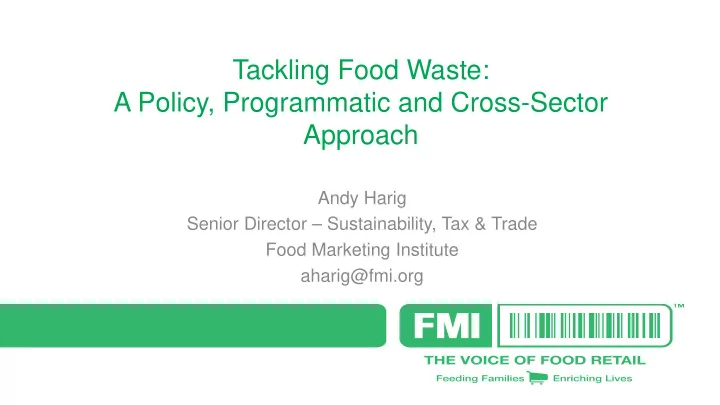

Tackling Food Waste: A Policy, Programmatic and Cross-Sector Approach Andy Harig Senior Director – Sustainability, Tax & Trade Food Marketing Institute aharig@fmi.org
Why Food Waste Matters – Economically, Ecologically and Socially # 1 60 Mil. 25 - 40 % Food that is grown, Tons of food waste processed and transported Source of municipal generated in the US in in the United States will solid waste in landfills 2010, 2/3 of which went to never be consumed. landfills. Source: FWRA 2
Why Food Waste Matters – Economically, Ecologically and Socially Resources Dedicated to Food 50% US Land Use 80% Fresh Water That Is Never for Agriculture for Agriculture Consumed (USA) $165 Billion 16% Methane 40% of All Food Emissions in Wasted Landfills Source: US EPA 3
USDA/EPA Food Waste Reduction Goals for USA September 16, 2015 • Agriculture Secretary Tom Vilsack and Environmental Protection Agency Deputy Administrator Stan Meiburg announced the United States' first-ever national food waste reduction goal. • It calls for a 50-percent reduction by 2030.
EPA’s Food Recovery Hierarchy
30 + manufacturing, retailing and foodservice companies, along with expert partners from the anti-hunger community and waste management sector. GOALS Reduce the amount of food waste generated • Increase the amount of safe, nutritious food donated to those in need • Recycle unavoidable food waste, diverting it from landfills
In order to accomplish these goals, FWRA’s efforts are divided into four workstreams: • Assessment – Measuring Food Waste • Emerging Solutions • Policy • Communications & Stakeholder Outreach
March 2012 - Food Waste: Tier 1 Assessment April 2013 - Analysis of U.S. Food Waste Among Food FWRA Manufacturers, Retailers, and Wholesalers Studies Produced 2014 - Analysis of U.S. Food Waste Among Food Manufacturers, Retailers, and Restaurants 2016 - Analysis of U.S. Food Waste Among Food Manufacturers, Retailers, and Restaurants Sample #
Talking Food Waste on Capitol Hill
May 25, 2016 – House Agriculture Committee Hearing “Food Waste from Field to Table”
Destination of Food Waste Manufacturing Retail
of respondents were unable to provide data regarding the quantity of food waste their companies disposed 12
and/or storage at Food Bank and/or storage at Food Bank and/or storage at Food Transportation constraints Transportation constraints Transportation constraints (distance, cost, fleet, etc.) (distance, cost, fleet, etc.) (distance, cost, fleet, etc.) Insufficient refrigeration Insufficient refrigeration Insufficient refrigeration Insufficient refrigeration Insufficient refrigeration Insufficient refrigera Regulatory Constraints Regulatory Constraints Regulatory Constraints and/or storage onsite and/or storage onsite and/or storage onsite Liability Concerns Liability Concerns Liability Concerns Other % o 10% 13% 20% 15% 17% 21% 30% 25% 25% to Don 40% 33% 42% 42% 50% 46% 46% 50% 60% 54% 70% 67% 69% 69% 80% 90% 2016 2014 2012 Retail Barriers to Donation
Incentives: Bill Emerson Good Samaritan Food Donation Act Protects donors from liability issues • when contributing to a non-profit with the exception of gross negligence or intentional misconduct Food Donation Tax Deduction Covers cost of carrying food • Does not make you whole • Document: fair market value, and cost of • food production 14
Other Industry Initiatives Find more information at: https://www.fmi.org/industry-topics/labeling/product-code-dating
Key Takeaways ► MEASURE! Need to strive to constantly improve tracking – Work with third parties to help – Implement internal tracking systems to collect and house all waste stream data in a central location ► Reach Out to Partners in the Supply Chain ► Build Food Waste Reduction into the DNA of the Company – Dedicate teams internally to develop and ‘own’ tracking and measurement systems
Thank you! Please feel free to contact me with any questions you might have: Andrew S. Harig 202-220-0628 aharig@fmi.org
Recommend
More recommend